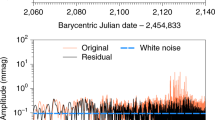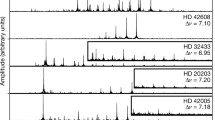Abstract
The life of a star is dominantly determined by the physical processes in the stellar interior. Unfortunately, we still have a poor understanding of how the stellar gas mixes near the stellar core, preventing precise predictions of stellar evolution1. The unknown nature of the mixing processes as well as the extent of the central mixed region is particularly problematic for massive stars2. Oscillations in stars with masses a few times that of the Sun offer a unique opportunity to disentangle the nature of various mixing processes, through the distinct signature they leave on period spacings in the gravity mode spectrum3. Here we report the detection of numerous gravity modes in a young star with a mass of about seven solar masses. The mean period spacing allows us to estimate the extent of the convective core, and the clear periodic deviation from the mean constrains the location of the chemical transition zone to be at about 10 per cent of the radius and rules out a clear-cut profile.
This is a preview of subscription content, access via your institution
Access options
Subscribe to this journal
Receive 51 print issues and online access
$199.00 per year
only $3.90 per issue
Buy this article
- Purchase on Springer Link
- Instant access to full article PDF
Prices may be subject to local taxes which are calculated during checkout




Similar content being viewed by others
References
Schaller, G., Schaerer, D., Meynet, G. & Maeder, A. New grids of stellar models from 0.8 to 120 solar masses at Z = 0.020 and Z = 0.001. Astron. Astrophys. Suppl. Ser. 96, 269–331 (1992)
Maeder, A. Physics, Formation and Evolution of Rotating Stars (Springer, 2009)
Miglio, A., Montalban, J., Noels, A. & Eggenberger, P. Probing the properties of convective cores through g modes: high-order g modes in SPB and Gamma Doradus stars. Mon. Not. R. Astron. Soc. 386, 1487–1502 (2008)
Auvergne, M. et al. The CoRoT satellite in flight: description and performance. Astron. Astrophys. 506, 411–424 (2009)
Aerts, C., Christensen-Dalsgaard, J. & Kurtz, D. W. Asteroseismology (Springer, 2009)
Leighton, R. B., Noyes, R. W. & Simon, G. W. Velocity fields in the solar atmosphere. Astrophys. J. 135, 474–499 (1962)
Ulrich, R. K. The five-minute oscillations on the solar surface. Astrophys. J. 162, 993–1002 (1970)
Leibacher, J. W. & Stein, R. F. A new description of the solar five-minute oscillation. Astrophys. Lett. 7, 191–192 (1971)
Deubner, F. L. Observations of low wavenumber nonradial eigenmodes of the sun. Astron. Astrophys. 44, 371–375 (1975)
Christensen-Dalsgaard, J. Helioseismology. Rev. Mod. Phys. 74, 1073–1129 (2002)
Chaplin, W. J. & Basu, S. Perspectives in global helioseismology and the road ahead. Sol. Phys. 1–2, 53–75 (2008)
Bedding, T. R. & Kjeldsen, H. Solar-like oscillations. Publ. Astron. Soc. Aust. 2, 203–212 (2003)
De Ridder, J. et al. Non-radial oscillation modes with long lifetimes in giant stars. Nature 459, 398–400 (2009)
Michel, E. et al. CoRoT measures solar-like oscillations and granulation in stars hotter than the sun. Science 322, 558–560 (2008)
Waelkens, C. Slowly pulsating B stars. Astron. Astrophys. 246, 453–468 (1991)
Krisciunas, K. A new class of pulsating stars. Bull. Am. Astron. Soc. 25, 1442–1443 (1993)
Dupret, M. A. Nonradial nonadiabatic stellar pulsations. Astron. Astrophys. 366, 166–173 (2001)
Degroote, P. et al. CoRoT's view of newly discovered B-star pulsators: results for 358 candidate B pulsators from the initial run's exoplanet field data. Astron. Astrophys. 506, 471–489 (2009)
Tassoul, M. Asymptotic approximations for stellar nonradial pulsations. Astrophys. J. Suppl. Ser. 43, 469–490 (1980)
Winget, D. E. et al. Asteroseismology of the DOV star PG 1159–035 with the Whole Earth Telescope. Astrophys. J. 378, 326–346 (1991)
Winget, D. E. et al. Whole earth telescope observations of the DBV white dwarf GD358. Astrophys. J. 430, 839–849 (1994)
Brassard, P., Fontaine, G., Wesemael, F. & Hansen, C. J. Adiabatic properties of pulsating DA white dwarfs. II — Mode trapping in compositionally stratified models. Astrophys. J. Suppl. Ser. 80, 369–401 (1992)
Andersen, J., Clausen, J. V. & Nordstrom, B. New strong evidence for the importance of convective overshooting in intermediate-mass stars. Astrophys. J. 363, L33–L36 (1990)
Baranne, A. et al. ELODIE: a spectrograph for accurate radial velocity measurements. Astron. Astrophys. Suppl. Ser. 119, 373–390 (1996)
Raskin, G. & Van Winckel, H. Hermes, a high-resolution fiber-fed spectrograph for the Mercator Telescope. Proc. SPIE 7014, 178–189 (2008)
Scuflaire, R. et al. CLÉS, Code Liégeois d'Évolution Stellaire. Astrophys. Space Sci. 316, 83–91 (2008)
Noels, A., Montalban, J., Miglio, A., Godart, M. & Ventura, P. Overshooting and semiconvection. Astrophys. Space Sci. 326, 233–243 (2009)
Aerts, C. et al. Asteroseismology of HD 129929: core overshooting and nonrigid rotation. Science 300, 1926–1928 (2003)
Aerts, C. Core overshooting and nonrigid internal rotation of massive stars. Proc. IAU 250, 237–244 (2008)
Aerts, C. & De Cat, P. Beta Cep stars from a spectroscopic point of view. Space Sci. Rev. 105, 453–492 (2003)
Acknowledgements
The research leading to these results received funding from the European Research Council under the European Community's Seventh Framework Programme (PROSPERITY), from the Research Council of KU Leuven and from the Belgian Federal Science Policy. The CoRoT space mission has been developed, and is operated by, CNES, with contributions from Austria, Belgium, Brazil, ESA, Germany and Spain.
Author Contributions P.D. and C.A. analysed and interpreted the light curve; M.B., A.M., A.N. and J.M. computed theoretical models; P.D., M.B. and E.N. analysed spectroscopic data; S.B., R.O., M.V. and K.S. made spectroscopic observations; and A.B., M.A., F.B., C.C. and E.M. are the CoRoT instrument builders.
Author information
Authors and Affiliations
Corresponding author
Ethics declarations
Competing interests
The authors declare no competing financial interests.
Supplementary information
Supplementary Information
This document describes in more detail the determination of the fundamental parameters, the frequency analysis and the period spacing extraction. It contains 3 supplementary figures, illustrating the determination of the fundamental parameters of the star, and providing an overview of the frequency content of the CoRoT light curve. A list of references relevant for the supplementary information only is added. (PDF 613 kb)
Rights and permissions
About this article
Cite this article
Degroote, P., Aerts, C., Baglin, A. et al. Deviations from a uniform period spacing of gravity modes in a massive star. Nature 464, 259–261 (2010). https://doi.org/10.1038/nature08864
Received:
Accepted:
Issue Date:
DOI: https://doi.org/10.1038/nature08864
This article is cited by
-
Making waves in massive star asteroseismology
Astrophysics and Space Science (2023)
-
Weighing stars from birth to death: mass determination methods across the HRD
The Astronomy and Astrophysics Review (2021)
-
Giant star seismology
The Astronomy and Astrophysics Review (2017)
-
The PLATO 2.0 mission
Experimental Astronomy (2014)
-
Magnetic Fields in Massive Stars, Their Winds, and Their Nebulae
Space Science Reviews (2012)
Comments
By submitting a comment you agree to abide by our Terms and Community Guidelines. If you find something abusive or that does not comply with our terms or guidelines please flag it as inappropriate.



